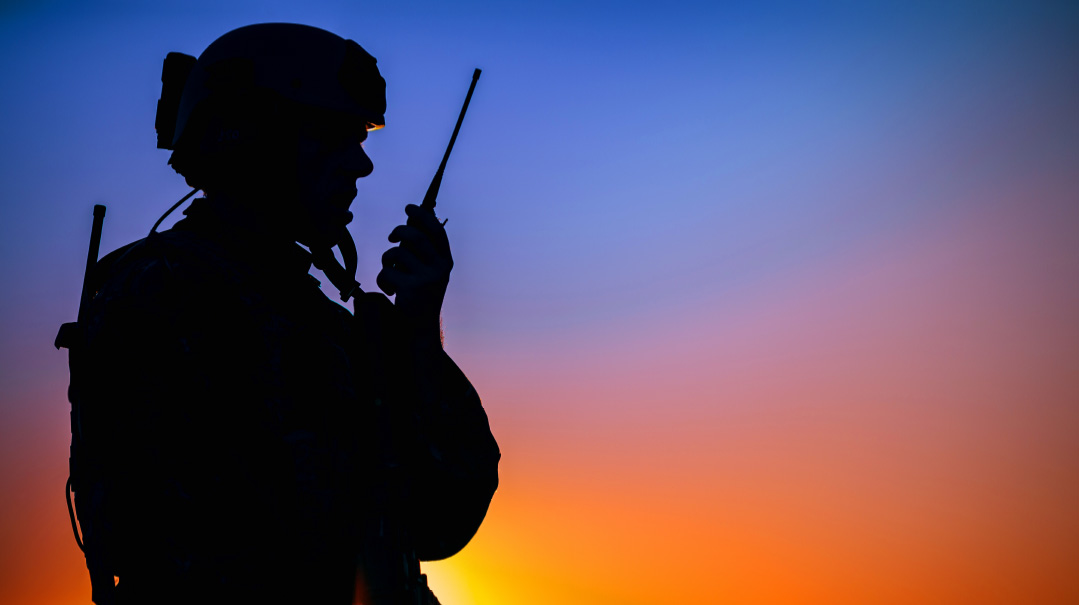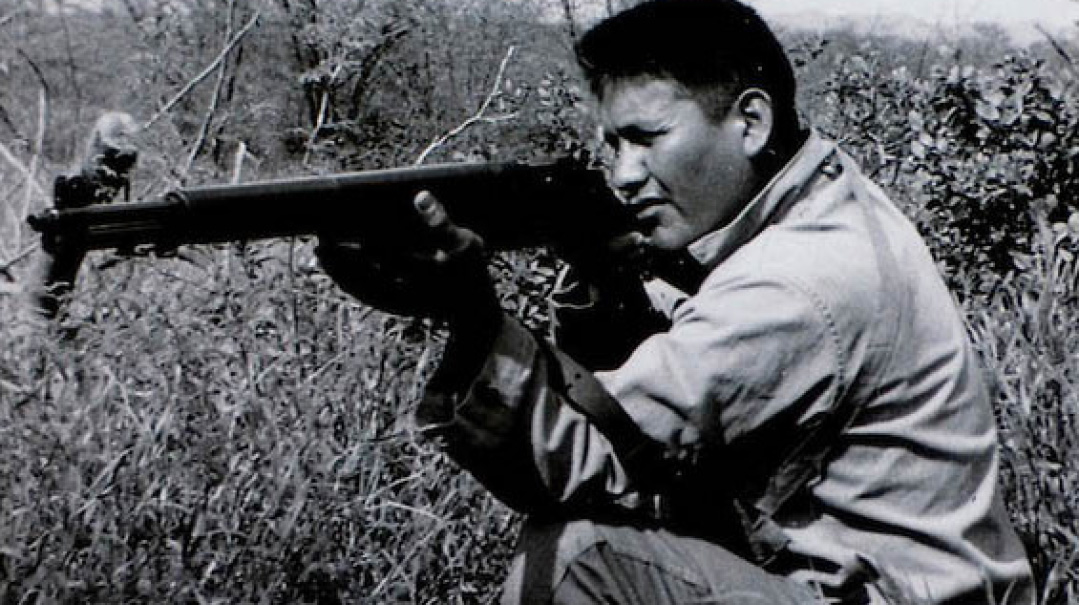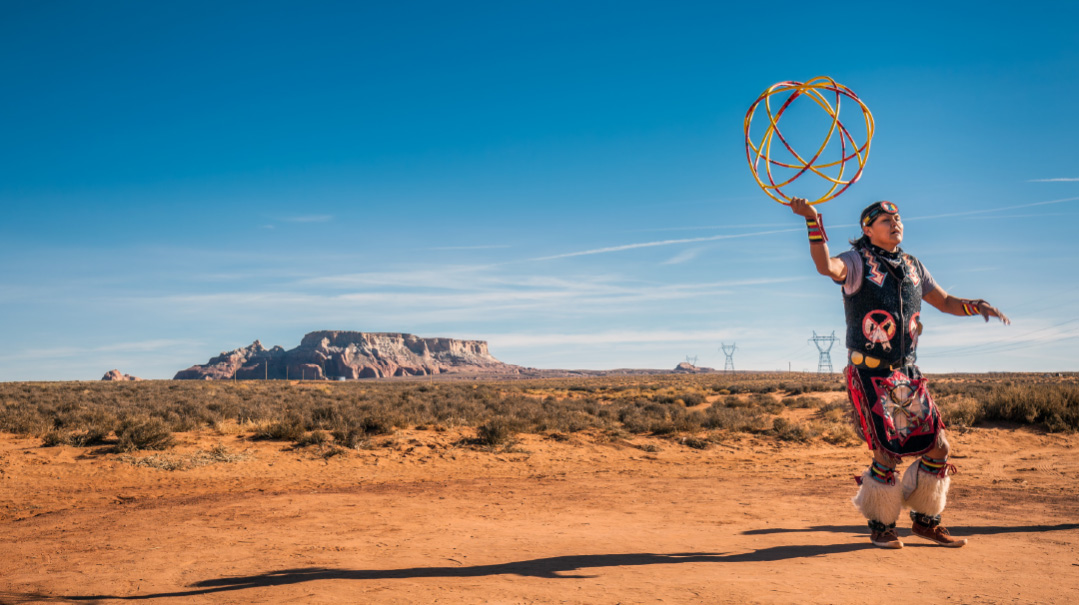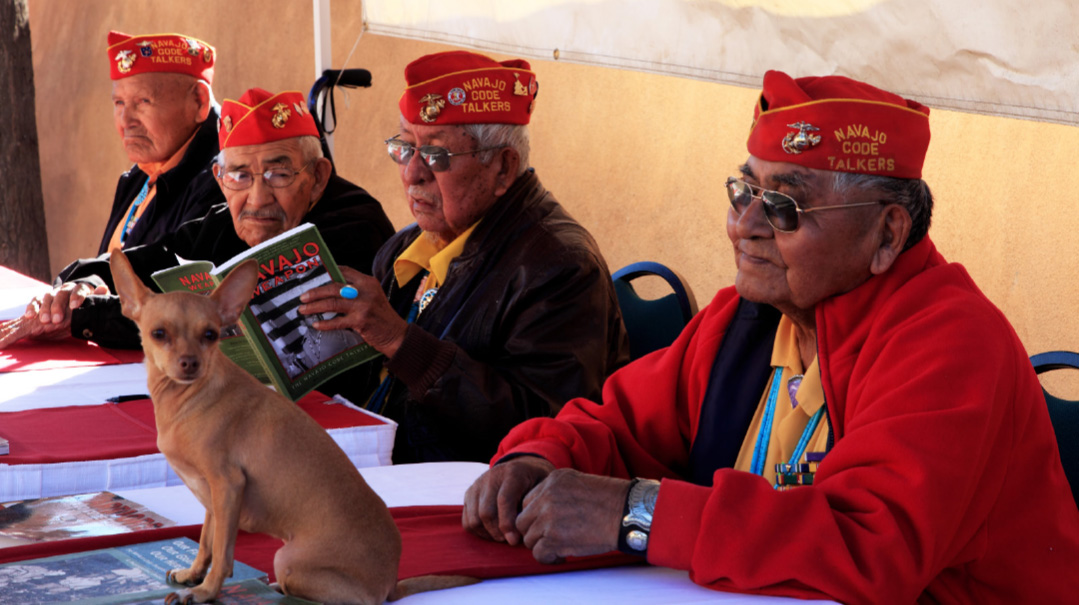Code Talkers

The mysterious Native American code that was never cracked

A lot of what goes in war is wild and loud — guns firing, shells whizzing, grenades exploding. But battles are not won with bullets alone. During a battle, communication is key. Soldiers on the front lines need to let their commanders at the field base know what’s going on. The commanders need to give instructions to the troops who are fighting. How do these messages get across the battlefield? And more importantly, how do you make sure that the enemy won’t intercept the messages and discover your tactics?
It’s all about the code that’s used to encrypt the messages, or make them super hard to understand. During World War II, a special group of US Marines developed a top secret code that was never broken. Read the story of how their code helped America defeat the Japanese in the South Pacific and eventually end the war.
Prologue
Is It the Japanese?
South Pacific Ocean — November 1942
The transport ship was full to the brim with US troops. After having been on board for several weeks, they had finally gotten over their seasickness and found their sea legs. The men were fresh from training and had never fired a gun in battle. Now, they were heading to Guadalcanal, an island in the South Pacific. For months, American troops had been fighting to take control of Guadalcanal from the Japanese. The men on the ship were going to join the fight.
One of the men was Chester Nez from New Mexico. He had volunteered for the Marines just a few months before and hadn’t seen his family since. Up on the deck, Chester gazed out at the flotilla his ship was travelling with. There were destroyers, battleships, cruisers, and more transport ships, all heading to Guadalcanal in the Solomon Islands.
Chester spotted his group of 12 friends in a corner and went to join them. While at sea, most of the troops passed the time by playing card games, singing songs, writing letters home to their families, and praying. But not Chester and his friends. The 13 men spent all day practicing the code they had created back in America. Once they reached land, these 13 men would be tasked with sending messages in the code. This was to be the very first time the code would be used in battle.
All the men on board were nervous and afraid. Would they die on Guadalcanal? But Chester and his friends were afraid of something more. They were worried about making mistakes in their coded messages. Their comrades’ lives depended on the messages being coded accurately. The smallest mistake could cost hundreds of lives. And so, they studied and restudied the entire code — all 200 words of it.
They practiced transmitting messages to each other and to their colleagues on other ships in the flotilla. They did all this in secret — none of their shipmates knew about the code. In fact, even the commanding officers knew nothing of this top-secret mission. Only a few admirals in the flotilla were aware of it.

One day, one of the ship’s radio operators intercepted a message that made his blood run cold. He immediately rushed over to his commanding officer.
“The Japanese have broken into our communications system,” he said breathlessly — the enemy had figured out how to understand the messages that the US military were sharing with each other!
The officer put on the radio headset and listened. He heard someone relaying a message in a foreign language. It sounded like Japanese.
The ship’s commander quickly informed the other ships that the Japanese had breached their communications. It was decided to shut down all US communications so that they could hear the Japanese messages. But there were no more such messages.
Eventually, one of the admirals informed the commanders that there was a group of Marines on board some of the ships who were communicating with each other in their native language.
“What you’re hearing is not Japanese,” the admiral said. “It’s Navajo.”

Chapter 1
The Navajo Nation
The Navajo Nation (pronounced “na-va-ho”) is a Native American tribe that lives across New Mexico, Arizona, and Utah. They are farmers and raise sheep and grow crops.
Chester Nez grew up on his grandparents’ farm near the Navajo Reservation between New Mexico and Arizona. Together with his older brothers and younger sister, Chester helped his grandparents shepherd their large flock of sheep. Their home was called “Chichiltah,” which is Navajo for “among the oak trees” Their land was nestled in a red canyon with a ravine and lots of oak trees. It was a beautiful, rugged place, and Chester had a wonderful childhood.
Still, life was pretty rough as a Navajo. The Navajos live a very simple life and have few luxuries. When Chester was growing up in the 1920s, his grandparents’ home was basically a shack made of wood. It was freezing in the winter and boiling in the summer, and forget about electricity! They didn’t even have proper beds.
During the day, Chester and his family would walk 15-20 miles as they moved the sheep to new pastures. They had to be on constant alert for coyotes, who would sneak up out of nowhere to snatch a juicy lamb. It was hard work. But at nightfall, they would build a campfire, and Chester’s father and grandfather would spend hours telling them the stories of their nation.
Every major event in the history of the Navajo Nation has a story. These stories are told at every opportunity. The elders repeat the stories, and the young ones listen, hanging on to every word and memorizing every detail. They know that one day they will be the ones repeating the stories to a new generation. With no written alphabet, the Navajo language is purely oral, which makes the retelling of the stories all the more important.
Chapter 2
Chester Nez Goes to Boarding School
When Chester was eight years old, his father said, “The government wants Navajo children to learn English.”
Nowadays, the Native American tribes live peacefully. But before the war, most people in American society thought they were savages — wild, uneducated people. By forcing the children to learn English, the government hoped to be able to control the tribes better. The government set up several boarding schools in old military forts, where Navajo kids were taught English and how to be “civilized.”
And so, Chester and his five-year-old sister Dora left for boarding school in Tohatchi, New Mexico. When they arrived, they were given American names, which they were expected to use from then on. The boarding school at Tohatchi was miserable. The kids were given very little food. Chester and Dora had always been slim, but when they returned home for their first visit, their family was shocked at how skinny they had become. It was decided that they would switch to the same school as their older brother, this one in Fort Defiance.
The matrons in Fort Defiance were super strict. The kids were not allowed to speak a word of Navajo. If they did, they were immediately punished. Eventually, the children learned English, if only to avoid being punished.
When vacation rolled around, Chester and Dora had to walk home. They were handed a stack of sandwiches and sent on their way. It took them three days! Because of their shepherding, the children were good at tracking and following trails. Sometimes, they met friendly strangers who invited them to stay the night. Otherwise, they simply slept out in the open. It was nothing they hadn’t done before at Chichiltah.
Chapter 3
America Is At War!
Chester went to boarding school for ten years. After he graduated from Fort Defiance, he went to high school in Gallup, New Mexico, and then to a school in Tuba City. In 1940, while Chester was at school in Tuba City, war was raging in Europe. America hadn’t yet joined the war, which is why it was so surprising when the Navajo Tribal Council declared their allegiance to the US. government. They passed a resolution in which they promised to help their country in war. This is especially amazing, since at the time, the Native Americans weren’t considered full US citizens and weren’t allowed to vote.
On December 7, 1941, the Japanese bombed the US Naval base at Pearl Harbor, Hawaii. America was now at war!
Chester and his roommate, Roy Begay, discussed the situation. “Our country has joined the war,” Chester said. “I think the military will want us. We are warriors.”
Chester was right. In April 1941, Marine recruiters arrived in Tuba City looking for Navajo men who spoke English. Chester and Roy decided to volunteer. They were interviewed by the Marines, and the interviews were entirely in English. They were very grateful that they had learned English, even if boarding school had been a nightmare.
On May 4, 1942, 29 Navajo recruits, including Chester and Roy, were shipped off to the Marine Corps Recruitment Center in San Diego. They became Platoon 382 in the 1st Marine Division. They spent the next seven weeks in basic training learning how to be soldiers. The military was very impressed with these young Navajos. At their final inspection after training was complete, the base commanding officer praised them to the skies. “We’ve never before had a group like this one,” he declared.
After basic training, all the new recruits were given a ten-day leave, so they could visit their families. But the 29 men in Platoon 382 were told that they were to be given a very special mission, and they had to begin training for it immediately.
They were sent to Camp Elliott, near San Diego, where an officer explained to them their mission. “The military needs an unbreakable code,” he said. “And you will be the ones to create it for us.”
Chapter 4
Do You Hear Navajo?
The Navajo language is one of the most difficult languages in the world. It is unwritten, and only spoken by Navajos. In the 1940s, it was estimated that just 30 non-Navajos spoke Navajo — but none of them were completely fluent. In Navajo, pronunciation is very important. You can have two words that are almost identical in sound, but their different pronunciations give them completely different meanings. It’s only possible to become truly fluent in Navajo if you hear it being spoken from birth.
When you want to know if someone knows English, you ask him, “Do you speak English?” In Navajo, they say, “Do you hear Navajo?” That’s because the words must be heard before they can be spoken. You can’t learn the language by reading it, since it’s not written. Also, non-Navajo speakers have a really hard time hearing all the different sounds in the language.
Native American languages had been used to transmit messages during WW1. After the war, Germany sent “scholars” to these tribes to learn their languages so they would be prepared in case of another war. But Navajo had never been used for codes before. Navajo was also better than the other Native American languages because the Navajos kept their language pure and didn’t add any English words. Every time a new technology appeared, like the electricity or the telephone, the tribe invented their own words.
The Marines were excited about using Navajo to create a new code. They recruited Chester, Roy, and the others specifically for this purpose. Now it was finally time for the men to begin their mission.
Chapter 5
B is For Shush
After he finished explaining the mission, the officer told the group of men to start by assigning a Navajo word for each letter of the English alphabet. Then, he left the room and locked the door!
Chester and his fellow Marines stared at each other in shock. Create a code so the enemy wouldn’t be able to understand what the American military was planning? They had no idea what to do! But they knew how important this mission was, and so they spent the rest of the day figuring it out. They had to choose words that would be clear when spoken on the radio, and they had to make sure that no two words would sound too similar. “A” became the Navajo word for red ant: “wol-la-chee.” “B” was bear, or “shush.” “C” was for cat, or “moasi.”
At the end of the day, an officer unlocked the room. He collected the papers that the Navajo men had worked on and put them in the safe.
For the next 13 weeks, the “original 29,” as Chester Nez and his group of friends later became known, worked on their code. Every single night, the men practiced and quizzed each other. They discovered that years of memorizing the Navajo stories had helped to sharpen their memories, which sure came in handy now! In battle, they would need to be able to relay and decipher messages in seconds. They had to learn to think English in their Navajo code! Unlike other coded messages, the Navajo codes would never be written down. Instead, the Navajo men were “code talkers” — they would speak the English message in code over the radio, and the code talker on the other end would write it down in English. Chester and his friends created a code of more than 200 words.
When the code was completed, 27 of the code-talkers were shipped off to the war zone at Guadalcanal. Two men remained behind to train new Navajo recruits to use the code.
When the code talkers arrived at Guadalcanal, the commanding signal officer, Lieutenant Hunt, doubted that their new code would pass muster. He decided to test it out. He gave a message to the new Navajo code talkers and gave the same message to the men who used the old code. He figured that it would take about four hours for the message to be transmitted and received in the old code. Guess how long it took for the Navajo code talkers to send and receive the message? Just two and a half minutes!
Chapter 6
Don’t Stop Talking
The code talkers worked in groups of ten. Four men stayed on the ship, where the commanders were running the show from behind the scenes. Six men went off to battle, and worked in pairs. Chester and Roy were paired together. Their job was to run around the battlefield, see where the Japanese were located, and send those locations back to their buddies on the ship. They also had to send back the numbers of American and Japanese dead and wounded. And they had to communicate with the other two pairs on the battlefield.
Chester and Roy took turns with the radio. One of them would relay and receive messages, while the other cranked the machine to power it. After a couple of hours, they would switch. The two partners constantly checked each other for mistakes.
That first day on Guadalcanal, Chester and Roy worked for more than 24 hours without sleep. After day two, it became obvious to everyone that the new code was essential and might even change the course of the war.
For two months, the code talkers worked from five a.m. until nightfall. Members of the US military kept coming at them with new messages to send. The receive signal on the radio was always flashing red, indicating that a new message was coming in. It was non-stop talking, talking, talking! Chester had never talked so much in his life! And it was all done while under a constant barrage of flying bullets and exploding artillery shells.
At night, the fighting basically stopped. The Japanese got tired, too. The weary troops would hunker down in the tight foxholes that they had dug and try to get some sleep. The weather in the South Pacific was humid and sticky, and it almost always rained. The mosquitos were relentless, and the crocodiles liked to attack at night. Often, the enemy was just a few feet away! It was hard to sleep when everything was so uncomfortable, but the Navajo men were used to rough conditions, which made things a little easier to bear.

(l-r): Navajo Code Talkers-Robert Walley, Alfred Newman, Bill Toledo, Jack Jones – part of over 400 Talkers who helped us defeat the Japanese in the Pacific during WWII
Epilogue
War Heroes
Chester Nez remained in the South Pacific until January 1945. For more than three years, he talked his code. While the other men in their division were sent away from the battlefield for much needed R and R (rest and recuperation), the code talkers never got a break. Their work was far too important.
Chester entered the Marines as a private first class and wasn’t given a higher-ranking job during the war. That was because the Code Talkers were a new specialty, and the Marines had no idea how to promote them.
Before being shipped back home, Chester was reminded that he couldn’t tell anyone about his wartime mission. The Navajo Code Talkers program remained classified (top secret!) until 1968, which is when the world finally learned about the unbreakable code that helped America defeat the Japanese.
Many codes have been created by many militaries, but the Navajo code remains the only spoken military code that has never been deciphered — no one has ever been able to figure it out.
(Originally featured in Mishpacha Jr., Issue 956)
Oops! We could not locate your form.






